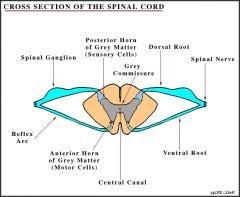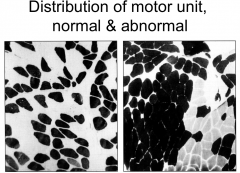![]()
![]()
![]()
Use LEFT and RIGHT arrow keys to navigate between flashcards;
Use UP and DOWN arrow keys to flip the card;
H to show hint;
A reads text to speech;
32 Cards in this Set
- Front
- Back
|
in muscles what is the "unit" of contraction |
the SARCOMERE |
|
|
in terms of filaments in muscle, what are the central filaments which stay stationary and what are the filaments which protrude in from Z lines on either side called? |
stationary + central filaments = myosin sliding filaments which portrude from Z lines on either side = actin |
|
|
active shortening against load requires the presence of what |
cross-bridges (XBs) |
|
|
how does the cross bridge interact between myosin and actin monomers |
cross bridges (XBs) reach out from MYOSIN filament to interact with ACTIN “monomers” (individual molecules) in thin filament |
|
|
the cross bridge interaction is only possible after what event has taken place? |
Ca2+ binds to troponin--> moving tropomyosin |
|
|
describe the the working stroke is in terms of cross bridges |
the myosin head pivots and bends as it pulls on the actin filament- thus sliding it towards the M line (M line is centre remember) |
|
|
when does the cross bridge detach from the actin monomer |
when the ATP attaches |
|
|
when ATP in the myosin head is hydrolysed and split into ADP and Pi, what characteristic movement of the myosin head occurs |

cocking of the myosin head occurs |
|
|
from where does the force for the "bend" in the myosin head occur |
within the XBs with the force generated at ATPase site |
|
|
what are the names given to the XB and the link subsequently |
XB --> S1 subunit link-->S2 |
|
|
what are the nerve cells whose axons innervate skeletal muscle fibres called and where do they reside |

they are called Lower Motor Neurones (LMN) they reside in the ventral horn of the spinal cord |
|
|
what is a motor unit |
A motor neurone plus the muscle fibres it innervates |
|
|
When an action potential occurs in the motor neurone, all the muscles fibres in its motor unit contract. Thus the motor unit is the unit of muscle control, though the individual fibre is the unit of growth and repair |
When an action potential occurs in the motor neurone, all the muscles fibres in its motor unit contract. Thus the motor unit is the unit of muscle control, though the individual fibre is the unit of growth and repair. |
|
|
all the muscle fibres of a muscle unit are always within the same muscle, but are they usually adjacent to each other, or scattered throughout the cell? what is the reason for this |

they are usually scattered throughout the muscle the reason for this is that if they were all adjacent to each other, then their simultaneous contraction doesn't produce local stress |
|
|
are motor units in smaller muscles smaller or larger than the ones found in larger muscles |
they are smaller... obvs
(E.g. in an external eye muscle one motor neurone innervates only ~10 fibres, yet in the large muscles of the back and legs the smallest motor units each contain hundreds of fibres and the largest ones may have thousands). |
|
|
Lower Motor Neurones (LMNs) differ in excitability, within one motor unit pool, how can you tell which neurones are the most excitable |
the smallest ones are the most excitable |
|
|
Because the smallest neurones in a particular motor unit pool are the most excitable, what does this mean in terms of which units will be recruited most often |
This means that the smallest units in a muscle are recruited for all contractions, even the weakest. Larger, less excitable neurones, are recruited only when the excitatory demand is greater: so their units contribute to the stronger responses, but not the weak ones. the bigger the unit, the higher its recruitment threshold. |
|
|
give the advantage of the size principle in motor units |
adjustments to the strength of a gentle action will themselves be small − the addition or subtraction of small units makes for smoothly graded changes. |
|
|
what type of myosin is used in slow gentle muscle movements |
the small, low-threshold motor units have slow myosin (Type 1 myosin) in their fibres |
|
|
what are the big strong units of the muscle contraction used for things like jumping and throwing that are able to contract fast |
myosin type 2 |
|
|
how do type 1 fibres manage to maintain their strength and participate in every action without fatigue so much longer than type 2 fibres |
• Slow myosin hydrolyses ATP at about 1/3 the rate of fast myosin, so can maintain a tetanic contraction 3x more economically • Type 1 are thus “slow, oxidative” fibres |
|
|
how much larger a cardio-respiratory system would be required for type 2 fibres to be aerobic |
2-3 larger a cardio-respiratory system, this isn't feasible considering we aren't woking at maximum capacity 99% of the time |
|
|
in what type of animals are 2A fibres most commonly found and are these fibres faster/slower and more aerobic/less aerobic than 2B/X fibres |
they are most commonly found in animals that are constantly doing fast frequent movements such as humming birds 2A is less fast than 2B/X 2A is found in fibres more aerobic than 2B/X |
|
|
what method is there for finding out which fibre type a certain muscle is just by |
• Quench-freeze small piece of muscle using liquid N2 • Cut series of sections from frozen block, transverse to muscle axis; quickly dry • React each section to demonstrate a different enzyme or metabolic store • Brown = myosin ATPase (contraction speed) Purple = SDH (oxidative capacity) |
|
|
in terms of their speed and oxidation give the 3 types of muscle fibre |
1: slow, oxidative 2B/X: fast, glycolytic |
|
|
what are the colours of the 3 different types of muscle fibre and what is the reason for their subsequent colours |
1: Red 2B/X: White
(Aerobic pigments give ‘red’ natural colour) |
|
|
as the: 1) % of tetanic force developed 2) % of the motor pool recruited 3) absolute force in kg increases, what is the progression in terms of the fibres used to carry out the actions |

1 > 2A > 2B/X |
|
|
will there be variation in a motor unit or will all the fibres be of the same type |
they will all be of the same type |
|
|
what frequency patterns do type 1 fibres elicit |
regular low frequency bursts |
|
|
what frequency patterns do type 2A fibres elicit |
regular high frequency bursts |
|
|
what frequency patterns do type 2B/X fibres elicit |
widely spread high frequency bursts |
|
|
if you were to look at any individual, which would be the largest fibres? |
the fibres that are used the most
In untrained people, all fibre types usually have similar size. In endurance athletes and regular walkers, Type 1 fibres are used most often and are the largest. It is only in strength and speed athletes that Types 2A and 2X/2B are larger than Type 1. |

